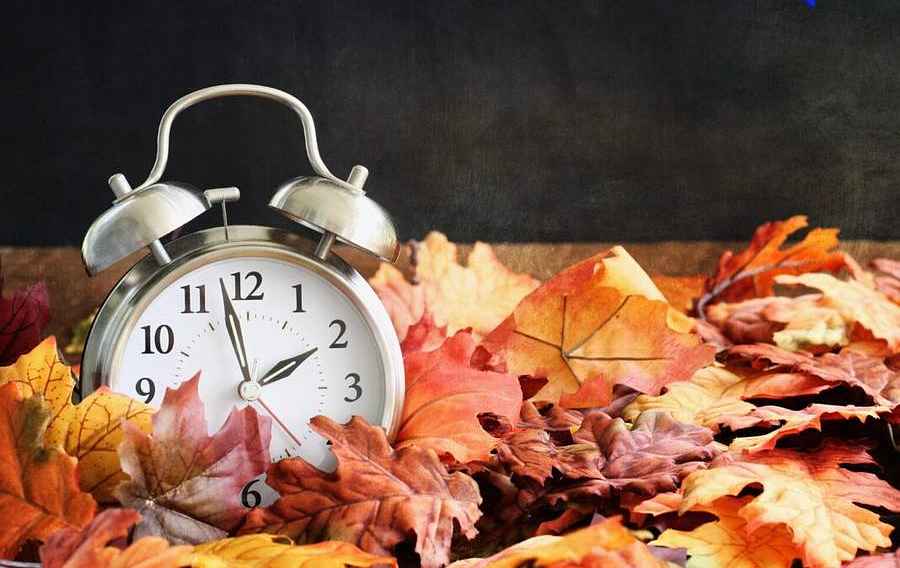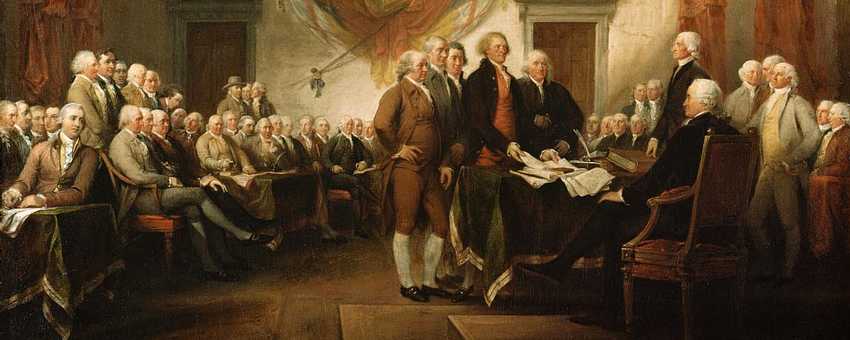






See listing of Recent and Most Popular articles on the Home Page
My World
Category: Holidays / Topics: Beliefs • Freedom • God • Government • July 4 (U.S. Independence Day)
What Did We Declare?
Exploring the meaning of our founding document
by Stu Johnson
Posted: July 4, 2015
Reading a novel inspires research about the document whose adoption we celebrate on July 4…
The other day I finished reading Jeffrey Archer’s novel Honor Among Thieves. My reading habits often involve discovering an author new to me and then working my way through that author’s works, so I’m still early on in his writing career. This novel was published in 1993. Its plot centers on a plan by Saddam Hussein to humiliate Bill Clinton, the newly inaugurated U.S. president, to steal the Declaration of Independence and then burn it in a very public display on July 4.
Carrying off the plan involves the use of a master forger to produce a replica of the engrossed (parchment) version of the Declaration. While the Declaration was widely distributed through printed copies, it is the engrossed version we are familiar with. Engrossing is the production of a document in fine lettering on parchment, normally made as the official document which is signed by those approving it. Engrossing is a very difficult task, made even more challenging by the quill pens used at that time. Through an elaborate ruse in Archer’s tale, the forger’s copy is switched with the original when the document descends into its protected underground vault at night. (Reminiscent of scenes from the 2004 movie “National Treasure.”)
Because his work is so good, the forger relies on a typo in the original document displayed at the National Archives in Washington, D.C. Timothy Matlack, widely believed to be the engrosser (master penmen) of the parchment version signed by the delegates, spelled British as “Brittish” in one instance. The forger spelled it correctly as a way of distinguishing the two documents.
As often happens when reading fiction with historical elements, I was curious about the facts behind the fiction, in this case knowing whether there was such a typo in one of our country’s most important documents. Sure enough, that part of the plot is correct. (In fact, the history of creating an authoritative reference copy the Constitution is even more intriguing—see the addendum.) My internet research on the Declaration led me to a more recent suggestion of a “new” typo and its interpretation.
Around the July 4 holiday last year, a flurry of news stories and blogs reported, some rather excitedly, that we may have been misinterpreting an important phrase in the Declaration of Independence. Here’s how it was reported on The Daily Beast on July 3, 2014.
One of the most famous phrases in American history may have had its meaning changed by a wayward drop of ink. According to the scholar Danielle Allen, the National Archives’ copy of the Declaration of Independence has an error—a period right after the phrase “life, liberty, and the pursuit of happiness.” That period, she says, has caused a “routine but serious misunderstanding” throughout history, thinking that the sentence ends there. In fact, it continues with “instituted among men, deriving their just powers from the consent of the governed.” The difference, she argues, is that “The logic of the sentence moves from the value of individual rights to the importance of government as a tool for protecting those rights. You lose that connection when the period gets added.” The errant period apparently does not exist on other copies, including Thomas Jefferson’s rough draft. As a result of Allen’s work, the National Archives is considering changes to its online presentation of the Declaration. [1]
Carrying on the discussion started by Allen (who wrote about the it in Our Declaration, Liveright, 2014), the Institute for Advanced Study (IAS) at Princeton partnered with the National Archives to host a conference on the Declaration on June 23 of this year. [2]
According to the press release about that conference issued by IAS:
Ms. Allen’s research raises questions about the transcription of the Declaration taken from the 1823 Stone engraving. Specifically, that the Stone engraving uses a period after “pursuit of happiness,” whereas the 1776 manuscripts by Thomas Jefferson, John Adams, and Secretary for the Continental Congress Charles Thomson use semicolons or commas. She argues that the question of whether a period belongs there affects whether we read a sentence with three self-evident truths, or with five. And it affects whether we take the self-evident truths to concern primarily individual rights or rather to concern the positive value of government as a tool for securing individual rights.
What struck me in all the reports I read was not only the shifting focus on the centrality and power of government in defining and protecting rights, but the diminishment or outright dismissal of the preceding clause about the divine origins of rights. The whole sentence deserves a reading.
The Declaration of Independence has a number of run-on sentences and Thomas Jefferson, its chief author, uses dashes to break up clauses throughout the Declaration. Whether the punctuation in question is a period, a colon, or a semicolon, the following clause about the role of government is surrounded by dashes, which also means there is something following that clause that is related. Here is the full text of that portion of the Declaration from the transcript used by the National Archives, the beginning of the second paragraph:
We hold these truths to be self-evident, that all men are created equal, that they are endowed by their Creator with certain unalienable Rights, that among these are Life, Liberty and the pursuit of Happiness.--That to secure these rights, Governments are instituted among Men, deriving their just powers from the consent of the governed, --That whenever any Form of Government becomes destructive of these ends, it is the Right of the People to alter or to abolish it, and to institute new Government, laying its foundation on such principles and organizing its powers in such form, as to them shall seem most likely to effect their Safety and Happiness. [3]
What is missing from the articles about Allen’s concern for the errant period, which causes her to claim greater power for the government (the point several news stories seized upon), are two things: the source of the self-evident truths (“all men are created equal” and “endowed by their Creator”), and the continuation of the sentence beyond the phrase in question to emphasize the power of the people when government exceeds their consent. After first noting the need for prudence, which emphasizes the seriousness of the situation at hand, the Declaration itself goes on in considerable detail to list the grievances the thirteen colonies have with British rule. It is not unlike some of the arguments today about government in America as it has evolved since the Revolution.
While America remains a highly religious nation [4], we are on an accelerating path toward European-style secularism. Worldview becomes critical, because people can be viewing the world through entirely different lenses. Your worldview will impact your reading of the Declaration, the perception of the source of human rights, and the resulting role of government.
I encourage you to read the entire Declaration of Independence. Imagine the sense of tyranny felt by those who signed that document (and the sense of betrayal by those who felt they were scandalous trouble makers). Read the entire context of the second paragraph without skipping over any words.
Have a happy Fourth of July as you celebrate life, liberty and the pursuit of happiness!
Addendum. For those interested in the history of our founding documents.
A good illustration of the problem of errors creeping into a document and then being perpetuated and expanded in later copies can be found in Henry Bain’s article “Errors in the Constitution—Typographical and Congressional.” [5] Bain describes the effort to produce the first engrossed copy of the Constitution:
The earliest of the Constitution's errors were made by the scribe who produced the engrossed (written in a fine round hand) parchment and the printers who produced versions of the newly completed document in September 1787.
Production of the engrossed copy must have occupied much of the weekend remaining after the Convention's adjournment late on Saturday, September 15. The scribe was Jacob Shallus, assistant clerk of the Pennsylvania legislature. He did a fine job given the short time he had, spreading the more than 4,000 words across four large sheets of parchment.
After he finished, Shallus had to deal with several mistakes that he had made during that rushed weekend of exacting labor. Many of the mistakes were omissions, and he tried to take care of each by inserting a word or two between the lines. But he also used a penknife to scrape away an entire line of text near the bottom of page one, leaving behind a roughed-up band that now appears gray from grime.
Another correction was the result not of a mistake, but of a last-minute change of mind by the Convention during the Monday session, when it increased the maximum allowable number of representatives from one per 40,000 persons to one per 30,000.
Also on page one are a number of ink splotches large and small, which occurred in the effort to complete this large document. Writing with a quill pen was a challenge.
On the last sheet, Shallus inscribed a record of the insertions so no one could think these might be illegitimate additions to the adopted text. After making his correction of the population per representative, Shallus explained it in his note of corrections: "The Word Thirty being partly written on an Erazure." Erasing ink isn't easy, and Shallus's effort to scrape away "forty" is easily detectable. [The engrossed version of the Declaration of Independence has a note on the back stating “Original Declaration of Independence, dated 4th July 1776” (6)]
Bain goes on to describe how small variations proliferated in the early decades of the new nation. “A casual attitude to details of punctuation and orthography, which prevailed among printers and publishers in the nation's early years, allowed errors or irregularities to multiply.” Encouraging this situation was the absence of a standard, official edition available to printers.
This was addressed in the 1840s by William Hickey, a member of the Senate’s clerical staff whose meticulous research produced an official version that could be used as an official reference copy. The first edition was certified by Secretary of State James Buchanan in 1847. Hickey’s work was carried forward as amendments were added to the Constitution. Today, the Government Printing Office is responsible for maintaining the official reference version of the Constitution.
NOTES:
- “Typo Changes Declaration of Independence” - www.thedailybeast.com/cheats/2014/07/03/typo-changes-declaration-of-independence.html The Daily Beast article references a longer article in the New York Times at www.nytimes.com/2014/07/03/us/politics/a-period-is-questioned-in-the-declaration-of-independence.html
- See news release at www.ias.edu/punctuating-happiness
- The official transcript of the Declaration of Independence includes the period - www.archives.gov/exhibits/charters/declaration_transcript.html
- See the Religion in America section on my website www.sjassociates.com/projects/religion_in_america
- “Errors in the Constitution—Typographical and Congressional” by Henry Bain, from Prologue Magazine, Fall 2012 issue, posted on the National Archives website www.archives.gov/publications/prologue/2012/fall/const-errors.html
- www.archives.gov/exhibits/charters/treasure/declaration_facts.html
This article was also posted on the Stuart Johnson & Associates website
Search all articles by Stu Johnson
Stu Johnson is principal of Stuart Johnson & Associates, a communications consultancy in Wheaton, Illinois. He is publisher and editor of SeniorLifestyle, writes the InfoMatters blog on his own website and contributes articles for SeniorLifestyle. • Author bio (website*) • E-mail the author (moc.setaicossajs@uts*) • Author's website (personal or primary**)* For web-based email, you may need to copy and paste the address yourself.
** opens in a new tab or window. Close it to return here.
Posted: July 4, 2015 Accessed 391 times
![]() Go to the list of most recent My World Articles
Go to the list of most recent My World Articles
![]() Search My World (You can expand the search to the entire site)
Search My World (You can expand the search to the entire site)
![]() Go to the list of Most Recent and Most Popular Articles across the site (Home Page)
Go to the list of Most Recent and Most Popular Articles across the site (Home Page)
 Loading requested view...
Loading requested view...